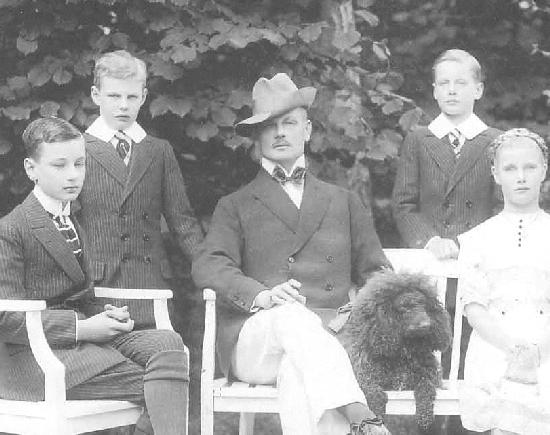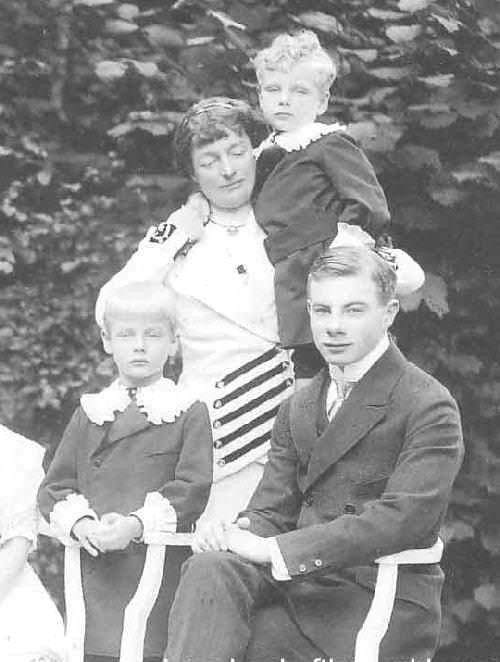

European Royalty: Thurn and Taxis--Albert I (1867-1952)

Figure 1.--Prince Albert is seen here in 1910 with Karl August, Ludwig Phillipe, Max Emanuel and Elisabeth. Note that the boys are dressed simarly in stripped suits. The only difference is that Karl August like his older brother below has a wing collar, but his two younger brothers have Eton collars.
|
Albert's grandfather Maximilian Karl married Baroness Wilhelmine von Drönberg
(1804-1835). Their son Prince Maximilian, Albert's father, brought the family close to
the imperial throne. He married Duchess Helene of Bavaria in 1858. She was the sister
of Empress Elisabeth who married Emperor Franz Joseph. We have no information on
Albert's childhood except that his father died when he was still a young boy. Helen had
to raise the children without her husband. They grew up primarily at the family's vast St.
Emmeran Palace in Regensburg. We have no information on the clothes that they wore.
Prince Albert in 1885 at age 18 becomes the reining prince. Albert married
Margarethe of Habsburg, a daughter of Archduke Joseph and Princess Clotilde of
Saxe-Coburg-Gotha, sister of Tsar Ferdinand I of Bulgaria. Prince Albert was famous
throughout Europe for the family fortune that he controlled. He administered a vast
business empire. When he became reining prince, the family had more than a dozen
palaces and castles around Regensburg and within various parts of the Habsburg
Empire. The Thurn and Taxis family were also among the largest landowners
in Central Europe. Prince Albert was a patron of the arts. The court balls at
Regensburg were legendary and he expanded the family's already imense art
collection. Albert and Margarethe had eight children. Prince Albert opposed to the
rise of Adolph Hitler. As the NAZI regime grew in power. the Prince increased his
opposition to NAZIism. Hitler was suspicious of Albert and his family, but took no
action against them. The Thurn and Taxis family like most Germans paid a terrible
price. Family members were drafted into the army. Not only did Prince Gabriel die in
1942 at Stalingrad, but 2 years later in 1944, Prince Anselm-Albert , another grandson
of Prince Albert, was killed. The family after the War lost vast properties confiscated
by the Communists in East Germany and other Eastern European countries.
Parents
Albert's grandfather Maximilian Karl married Baroness Wilhelmine von Drönberg
(1804-1835). Their son Prince Maximilian, Albert's father, brought the family close to
the imperial throne. He married Duchess Helene of Bavaria in 1858. She was the sister
of Empress Elisabeth who married Emperor Franz Joseph. Helene was in fact initially
chosen to
marry the Emperor, but her beautiful and engaging younger sister attracted the the
young Emperor's attention. Another sister, Sofie, was engaged to their cousin King
Ludwig II of Bavaria.
Siblings
Maximilian through the marriage became the Emperor's brother-in-law. Maximilian
and Helene had a happy marriage and had four children:
Louisa (1859-1948), Elisabeth (1860-81), Maximilian (1862-1885) and Albert
(1867-1952). Unfortunately Maximilian died unexpectedly in 1867. The children as
they were first cousin's of the future Austrian emperor were eligible for marriage to
ranking European royals. Louisa von Thurn und Taxis married Prince Friedrich of
Hollezollern-Sigmaringen a
brother of King Carol I of Romania. Princess Elisabeth married Prince Miguel, Duke of
Braganza in 1877.
Childhood
We have no information on Albert's childhood except that his father died when he
was still a young boy. Helen had to raise the children without her husband. They grew
up primarily at the family's vast St. Emmeran Palace in Regensburg. We have no
information on the clothes that they wore.
Reining Prince
Prince Albert in 1885 at age 18 becomes the reining prince.

Figure 2.--Princess Margarethe of Habsburg, a daughter of Archduke Joseph and
Princess Clotilde of Saxe-Coburg-Gotha, is seen here in 1910 with Raphel, Philipp
Ernst, and Franz Joseph.
|
Marriage
Albert married Margarethe of Habsburg, a daughter of Archduke Joseph and
Princess Clotilde of Saxe-Coburg-Gotha, sister of Tsar Ferdinand I of Bulgaria.
Family Fortune
Prince Albert was famous throughout Europe for the family fortune that he
controlled. He administered a vast business empire. When he became reining prince,
the family had more than a dozen palaces and castles around Regensburg and within
various parts of the Habsburg Empire. The Thurn and Taxis family were also among
the largest landowners
in Central Europe.
Patron of the Arts
Prince Albert was a patron of the arts. The court balls at Regensburg were
legendary and he expanded the family's already immense art collection.
Children
Albert and Margarethe had eight children. One of the children did not survive
infancy, Joseph Albert (1895). Six of the remaining seven children were boys. The eldests surviving boy, Franz Joseph (1893-1971) was named after the Emperor Franz Joseph
of Austria. He and his next younger brother, Karl-August (1898-1982), married two sisters, the
Portuguese Infantas (princesses) Elisabeth and Maria-Anna of Braganza, daughters of
Miguel, Duke of Braganza. The other children were Prince Ludwig Philip (1901-33), Maximillian Emanuel (1902-94) (he became a catholic Monk in Regensburg), Princess Elisabeth (1903--76) (Markgräfin
von Meissen), Prince Raphael Reiner (1906-93), and Prince Philipp Ernst (1908-64).
Children's Clothes
Princess Margarethe apparently believed in dressing the boys similarly, at least
those relatively close in age. The family portrait here is a good example of families at
the time dressing children similarly, but using major and minor differences in the outfits
to recognize age differences. Their father Prince Albert appears to have been rather a
rakish dresser, at least that is the impression he gives with his hat and jaunty bow tie.
The boys are dressed more conservatively. The oldest boy Prince Franz Josef
differently than the rest in a dark long pants suit and wing collar. The next three boys
(Karl-August, Ludwig Phillipe, and Max Emanuel) are dressed similarly in stripped
suits. The only difference is that Karl August like his older brother has a wing collar and
his two younger brothers have Eton collars. While the oldest brother wears long pants,
his next youngest brother wears knickers, the kind with the kneesocks are pulled
over the knickers hem. The socks are quire long and make a heavy turn-over-top cuff.
The next two brothers in identical suits, but Eton collars, presumably had similar pants,
although they are in the back row and their pants are covered up. The youngest two
brothers wear a jacket or tunic with side buttons and ruffled collars. One of these boys
has bangs and the younger curly hair.
World War I
We have no information as to how Prince Albert and his family fared in World War I. We do know that Princess Margarethe was active in nursing.
Hitler
Prince Albert opposed to the rise of Adolph Hitler. As the NAZI regime grew in
power. the Prince increased his opposition to NAZIism. Hitler was suspicious of
Albert and his family, but took no action against them. I assume his children were also
anti-NAZI following their father's lead. O am not sure about the grandchildren,
especially Prince Anselem and Prince Johannes. They were of an age that they
presumably had to join the Hitler Youth. I do not know what affect this had on them.
World War II
The Thurn and Taxis family like most Germans paid a terrible price for Hitler and
the NAZIs. Family members were drafted into the army. Prince Gabriel die in 1942 at
Stalingrad. Prince Anselem-Albert, another grandson, 2 years later was killed in action
during 1944. Like other Germans, what ever their attitudes toward the NAZIs, these
boys had to fight in the army for the NAZIs. The family after the War lost vast
properties confiscated by the Communists in East Germany and other Eastern European
countries.
Later Years
Albert died in 1952. He was succeeded by his eldest son Franz Joseph
(1893-1971). Albert never turned control of the family fortune over to Franz Joseph or
his brother Karl Auguste. Rather on his death, control of the fortune went to his
grandson Johannes, the son of Karl Auguste.
HBRC

Navigate the Boys' Historical Clothing Web Site royal pages:
[Main Thurn and Taxis page]
[Main German royal page]
[Main royal pages]
[Austria]
[Belgium]
[Denmark]
[France]
[German Empire]
[Italy]
[Luxenburg]
[Monaco]
[Netherlands]
[Norway]
[Romania]
[Russia]
[Spain]
[United Kingdom]
Created: August 1, 2002
Spell checked: August 1, 2002
Last updated: March 13, 2003





